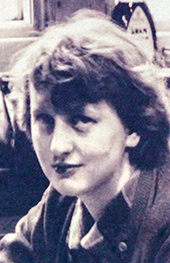
Hazel 1929-2015
Hazel didn’t have M.E. but she suffered a kind of death whereby the Grace Charity feels the need to warn all vulnerable people.
Hazel was Catherine Ashenfelter’s Mum (trustee of the Grace Charity for M.E.) She was put on an ‘End of Life’ Pathway in hospital for the ‘dying’, even though Catherine doesn’t believe that her Mum was dying when admitted there. This pathway is virtually identical to the Liverpool Care Pathway (LCP) which was meant to be stopped by 2014, when hospitals were assessing some patients as ‘dying’, although they weren’t, and consequently depriving them of food and fluid; this made the diagnosis of ‘dying’ self-fulfilling, as a patient would inevitably die once placed on the pathway.
Hospitals even admitted to being given financial rewards for meeting target numbers of patients put on the LCP. 1
Tragically, the LCP doesn’t seem to have gone away but still exists under the label EOL (End of Life care). Signs of the Liverpool Care Pathway are sedation, regular medicines and active treatment stopped; worse of all food and fluid can be unnecessarily withheld. In the past many families didn’t know that their loved ones were put on the Liverpool Care Pathway until after or just before they died; they also didn’t believe that their loved ones were actually dying when admitted to hospital. The same horror seems to still be happening today.
We don’t want to scare M.E. sufferers unnecessarily, as going into hospital is difficult enough for them.
We do, though, want everyone to know what is still going on and to pass on knowledge which might be able to stop someone unnecessarily being put on the LCP/EOL .
We are also concerned about the attitude emerging towards the weak and disabled; whilst the LCP/EOL is mainly for the elderly, younger patients have been put on it on the NHS in the UK.
Knowledge is power

Hazel’s story
In September 2015, Hazel aged 86 was admitted to the William Harvey Hospital, Ashford, Kent with suspected pneumonia. She’d had this condition twice previously in the same year, both times with hospital admittance. When admitted for the third time in September, Hazel could eat and drink normally and hold a conversation; she was diabetic, needing daily insulin. Her potassium and blood sugar levels were in ‘safe range’. She’d been bed/chair bound for a year after breaking her right leg; whilst the leg had healed well, it was non-weight bearing, so she needed to be hoisted.
The day after admittance, a nurse wrote that Hazel ‘ate a good breakfast of porridge. Swallowing normally, no issues at present. Taking all tablets orally very well.’ Hazel was also drinking cups of tea and cartons of fruit juice. It was therefore surprising when a SALT (Speech and Language Therapist) advised that Hazel was to only have pureed food with teaspoons of fluid fed by nurses – in other words, a vastly restricted diet. This was in case she was aspirating (food and drink going down the trachea instead of the oesophagus –the wrong pipe, so to speak). But a formal swallowing assessment was never carried out – it was just ‘advice’ which evolved into an instruction. But Hazel’s dietary chart shows that she received no pureed food or fluid from nurses, and only a few sips of juice given by family for the duration of a whole week. In time, her ‘alleged’ swallowing problems further evolved to Nil By Mouth (NBM) although none of Hazel’s children (two daughters, two sons) were informed of this. The NBM label also meant that Hazel’s daily medicines could not be given, including Bisoprol for heart failure.
Without knowing the NBM label, Catherine’s elder brother fed Hazel some solid food of a lamb hot pot meal which she really wanted and ate it all. This was the only decent meal she had in a week. The judgement of her medical team was incorrect – Hazel didn’t appear to have any swallowing problems and was instead extremely hungry and thirsty.
Hazel was given intro-venous fluid at times, both saline and dextrose. But the week-end before she died, blood tests revealed she was dehydrated. Instead of increasing her fluid intake, it was decreased. In addition to this, Hazel was being ‘treated’ with a bi-pap machine, which family were told was the only hope for her recovery. It delivered oxygen through a tight fitting face mask, forcing her to breathe. The medical team told family it would dry out her throat due to the extremely dry air, but the family didn’t know she wasn’t being adequately hydrated whilst on it.
The mask dried her throat out so much that she couldn’t speak.
When her fluid was reduced, the hospital continued to place the mask on her face, sometimes at the highest setting, which could only have dehydrated her further. The consultant ordered the mask to be continued when no fluid at all was given for 24 hours.
Over the week-end when Hazel’s blood tests showed she was dehydrated, she was given just 1 litre for the whole day. (She should have had a minimum of 2 litres daily). The following day, she was only given 250 mls. and the next day she had her drip completely withdrawn, yet the mask of dry air was still placed upon her face. When Catherine asked the consultant to put back her mother’s drip, the consultant refused to do so, replying that Hazel had enough fluid in her body as her hands and arms were very swollen. But oedema (swelling) can be a sign of dehydration, as the body is retaining fluid simply because it’s dehydrated. Hazel died the day after having her drip removed, 4 days after her blood tests showed she was dehydrated.
In spite of several meetings with doctors when Hazel was alive, her 4 children didn’t know the following:
- That she’d been Nil By Mouth for at least 5 days before she died.
- That she’d had her daily medicines stopped, almost a week before she died.
- That her blood tests showed she was dehydrated.
- That she was given less fluid when dehydrated.
- They didn’t know how little she’d had to eat and drink whilst in hospital.
In a written response from the Chief Executive of the William Harvey Hospital regarding Hazel’s death, he refused to answer Catherine’s question if the hospital permits the practice of involuntary euthanasia (when people are killed who don’t ask to die). Involuntary euthanasia is illegal.
His response included eleven apologies, mainly from Hazel’s hospital consultant. It also included an extraordinary statement from the consultant, saying that if Hazel had shown signs of wanting to eat and drink, she could have done so and the team would have accepted the risk of aspiration. This statement showed that the Nil By Mouth label imposed upon Hazel for at least 5 days before she died (and kept from her family), wasn’t really a medical necessity.
Catherine believes that her Mum must have died from dehydration, either as a main cause or certainly as a contributory factor, although this wasn’t written on the death certificate. Dying from dehydration is an agonising death; so much so that a pro-euthanasia spokesperson has said “If we can get people to accept the removal of all treatment and care – especially the removal of food and fluids – they will see what a painful way this is to die and then, in the patient’s best interest, they will accept the lethal injection.”2 (The Grace Charity for M.E. is not recommending any particular way to die – we just want to point out the agonising death of food/fluid deprivation.)
It takes an average of three days to die from dehydration, even if you’re young and healthy; you must have adequate fluid intake to survive. (It can take sooner or longer than three days, depending on the conditions/circumstances.) Adequate daily hydration is important. It is never too late to hydrate. It can save someone from dying from dehydration, even in the last minutes.
The minimum amount of fluid a person needs is 2 litres daily for women and 2.5 litres for men; more is sometimes recommended. Diabetics need more fluid than others.

Attitudes to the vulnerable with disabilities
Our charity is particularly concerned about the devaluing attitudes to those with disabilities in the End of Life Pathway. Part of the consideration ‘tick box’ to diagnose if someone is dying includes ‘quality of life’3.
Catherine had a senior registrar say to her about her mother, “It’s not a nice life to be hoisted,” before placing her Mum on the End of Life pathway. (Hazel had been hoisted for the last year of her life after breaking her leg.) In addition, the death certificate said that one contributory factor Hazel died from was ‘biological frailty’; when Catherine questioned as to why this was even on the death certificate, the consultant replied that it was due to Hazel being bedbound with dependence for care.
Most people would agree that this description should have no place on a death certificate; the fact that Hazel needed daily care shouldn’t have been factored in as a ‘reason’ why she died. In addition, Hazel was strong in her upper body, able to feed herself from a knife and fork; she could still read, write, talk, eat and drink when admitted to hospital.
Regarding her ‘quality of life’, she’d had her hair done the day before being admitted to hospital and was looking forward to a family lunch at a nearby hotel. This is more than many disabled people can achieve.
‘Quality of life’ should have no place in a medical judgment to assess if someone is ‘dying’.
End of Life ‘care’
This often involves the withdrawal of food and fluid including via drip, even if the person isn’t really dying. This may seem difficult to believe and accept as current practice in the NHS, yet there is a dark side to the NHS which often includes their attitude to the illness M.E., the elderly and some other needy people.
The current thought nowadays seems to be that a ‘dying’ person needs less fluid over the last few days of their life, as they have ‘enough fluid’ in their body. But oedema (swelling of body tissues) can be a sign of dehydration – therefore, more not less fluid might be required.
NICE Guidelines to End of Life care
(16 December 2015)
The NICE Guidelines (National Institute for Health and Care Excellence) for the booklet ‘Care of dying adults in the last days of life’ are probably the reason why doctors can get away with placing patients on a death pathway who aren’t really dying. It states that ‘it can often be difficult to be certain that a person is dying’ 4. Also, ‘Recognising dying can be challenging for health and care professionals. There is often uncertainty about how long a person has left to live and the signs that suggest someone is dying are complex and subtle.’ 5
Once two doctors have agreed that a patient is ‘dying’, they go through a tick-box of information confirming this, including the patient’s quality of life. They look for signs such as fatigue, agitation, loss of appetite, changes in communication or social withdrawal (there are others to choose from).
The Guidelines then encourage doctors to write up medicine for ‘anticipatory prescribing’, which usually includes morphine or sedation, for when symptoms might occur which aren’t present at the time of prescribing them. Also, the restricting of food and drink which may include Nil By Mouth may be considered and the withdrawal of regular medicines.
The NICE Guidelines make a statement on hydration which is very alarming. They state that ‘it is uncertain if not giving clinically assisted hydration will hasten death.’6 This is simply untrue. Consultant neurologist Professor Patrick Pullicino, a prominent spokesperson against the ‘Liverpool Care Pathway’ is recorded as saying, ‘Not giving hydration is certain to kill someone if they can’t take hydration by mouth.’ 7

What Might Help You In This Situation
If you feel that your loved one might be in danger, look for the following:
- There is a phone number you can ring for advice and support if you feel that a loved one is at immediate threat of euthanasia. Patients First Network: 020 8407 3463
- Having Power of Attorney (Healthcare) can be very helpful in speaking up for your loved one, should they become unable to speak up for themselves. Some patients have had the Liverpool Care Pathway/End of Life approach stopped when their relative with Power of Attorney has intervened for them.
- If your loved one is being denied food and drink without good reason (including hydration via drip) then you could say that their human rights are being violated. (The Human Rights Act 1998 became UK Law. Article 2: The Right to Life. Article 3: No torture, inhuman or degrading treatment. Unnecessary starvation and dehydration can be used as examples of torture.)8
- Ask for another doctor’s opinion – quickly – especially one you can trust.
- Tell the Chief Executive (or deputy) of the hospital that you want to meet with him/her urgently as you feel your loved one is at risk in the hospital. Consider telling them you might take the event to the Press.
- Call the police if you feel that your loved one is at risk. (They may or may not help). Sometimes they’ve come out, sometimes not.
- If there is a safe place for your loved one to go to, legally you can get them out of impending danger, so long as they haven’t been sectioned into the hospital. This decision can’t be made lightly though, because if they die on the journey back with you, you might be accused of escalating their death. (Consider hiring a private ambulance if you’re not provided with an NHS ambulance.)
- The patient has a right to see their hospital notes, in line with the Data Protection Act 2018. If the patient is too unwell, consent for disclosure to a third party is lawful; this is usually the designated next-of-kin (name written in hospital records as NOK) who can then read the patient’s notes whilst still in hospital [9]; consent from the patient is needed, either beforehand in writing or signalling their permission in hospital. Some concerns may occur when your loved one is unconscious, so getting their written permission in advance for you to read hospital notes is the better option. If the hospital team are uncooperative about this, request to see the Chief Executive or similar person of hospital authority.
- Look if a NBM (Nil By Mouth) label has been written in the notes, on the wall or above/attached to head or foot of the bed. Question this if you feel it is an unnecessary decision. Sometimes there are codes in the notes which mean NBM. In my mother’s case, the nursing code was a figure 3.
- Look to see if the patient’s usual daily medicine has been stopped. If so, ask why. (Stopping regular prescriptions can be a sign of End of Life care.)
- Look to see if sedatives/morphine have been written up, even as ‘anticipatory prescribing’ (for symptoms which haven’t yet occurred). If so, ask why they’ve been written up. Sedatives and morphine tend to lower oxygen levels.
- Make sure the patient is getting enough to eat and drink. Check how much fluid they are being given – is it enough? (A guideline is a minimum of 2 litres daily – some will need more.) Don’t presume that the nurses are feeding your loved one, even if they’ve been told to – there are reasons why they might not get round to doing this. Check the dietary and fluid balance charts in the patient’s notes.
- If there are dietary restrictions due to ‘swallowing problems’, make sure a swallowing assessment has been carried out and ask to see it. Sometimes there is advice about ‘possible’ swallowing problems which might not be true and can be wrongly used to starve, dehydrate and stop giving medicines by mouth.
- If a DNR form (Do Not Resuscitate) has been issued by the hospital, this may mean that not much effort will be given to save the life of the patient next time they come to hospital. (This information has been given to us by a nurse.) DNR forms must only be issued in agreement by either the patient concerned or their next-of-kin. It is illegal for the hospital to issue them without consent – tragically, this does happen, though. So, it’s best to ask if a DNR form is on the loved one’s file and why.
- Wear a wrist band which says ‘I DON’T WANT an End of Life pathway.’ Have a photo taken of the patient wearing it as evidence, if admitted to a hospital, hospice or a care home.’
Will Things Change?
Until the NICE Guidelines for End of Life become less ambiguous, the vulnerable will continue to be at risk. Doctors intent on practising involuntary euthanasia will still be allowed to get away with it.
Also, the guessing of whether a patient is dying is still continuing. This guessing seems to be the core problem of the LCP/EOL .
Other people’s stories
The family of a 90 year old patient who was made Nil By Mouth and put on the death pathway, tell their experience. After questioning the doctors who later reneged on their decision, the patient was fed and hydrated again and went home alive.
www.bbc.co.uk/news/health-23698071 (Report 15th August 2013)
A 71 year-old patient who was put on the Liverpool care Pathway after judged as being ‘dying’. He was taken off the pathway by a different doctor and went home to live for a further 14 months. www.dailymail.co.uk/news/article-2161869 (Report 20 June 2012. Interview with Professor Patrick Pullicino.)
Hazel’s story is written up by the Kentish Express. It includes criticism of the GMC, the CQC, East Kent Hospitals Trust and Kent Police. East Kent Hospitals Trust ‘truly sorry’ for failings in care of grandmother who died at William Harvey Hospital in Ashford (kentonline.co.uk)
Contacts
A Meditation
A devout Christian, Hazel embraced a card with a picture of Christ two days before she died.
It is my sincere hope that my beloved mother’s death is not in vain and can be used as a warning to others, to prevent them from a similar agonising death.
‘Come, you who are blessed by my Father, inherit the kingdom prepared for you from the foundation of the world. For I was hungry and you gave me food, I was thirsty and you gave me drink, …..’ 10

Template Letter of a prepared statement if you or your advocate do not agree with an End of Life pathway
![]() Click to Download the Word Document 11Kb
Click to Download the Word Document 11Kb
![]() Click to Download the PDF Document 158 Kb
Click to Download the PDF Document 158 Kb
Letter giving permission for next-of-kin to read medical notes.
![]() Click to Download the Word Document 11Kb
Click to Download the Word Document 11Kb
![]() Click to Download the PDF Document 158 Kb
Click to Download the PDF Document 158 Kb
Booklet: No Hydration No Life available on request as a hard copy. Also, available here to freely download. Tips for printing the A5 booklet: print landscape; both sides of paper; PDF may need you to ‘shrink to fit’.
![]() NO HYDRATION NO LIFE A5 booklet 711 Kb
NO HYDRATION NO LIFE A5 booklet 711 Kb
![]() NO HYDRATION NO LIFE A5 booklet 553 Kb
NO HYDRATION NO LIFE A5 booklet 553 Kb
![]() NO HYDRATION NO LIFE A4 document 710 Kb
NO HYDRATION NO LIFE A4 document 710 Kb
![]() NO HYDRATION NO LIFE A4 document 558 Kb
NO HYDRATION NO LIFE A4 document 558 Kb
- ‘NHS Millions For Controversial Care Pathway’, The Telegraph 31 Oct. 2012 by John Bingham: http://www.telegraph.co.uk/news/health/news/9644287/NHS-millions-for-controversial-care-pathway.html
- Dr. Helga Kuhse, at the Fifth Biennal Congress of Societies for the Right to Die, held at Nice, France Sept. 1984
- The NICE Guidelines (National Institute for Health and Care Excellence) for Care of dying adults in the last days of life December 16 2015, page 23.
- Ibid, page 5.
- Ibid, page 18.
- Ibid, page 10 1.4.5
- Professor Patrick Pullicino writes in the Telegraph 3rd August 2015, The new end-of-life guidelines are lethal http://www.telegraph.co.uk/news/health/news/11779213/New-death-guidelines-worse-than-Liverpool-Care-Pathway.html
- www.liberty-human-rights.org.uk The UK Human Rights Act 1998 was based on the Universal Declaration of Human Rights 1948. Article 25 of the UDHR: the right to food from an adequate standard of living; Article 31: the right to clean and accessible water, adequate for the health and well-being of the individual (UDHR). Whilst the Universal Declaration of Human Rights is recognised as a world standard, it is not legally binding. It can be used, though, as a weapon against those taking these rights away. The UK Humans Rights Act, however, IS law.
- The Medical Protection Society (Access to Health Records). https://www.medicalprotection.org/uk/resources/factsheets/england/england-factsheets/uk-eng-access-to-health-records
- Matthew 25 v 35 ESV translation.
